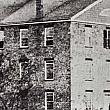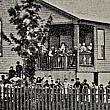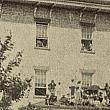
Stone School: District No. 1
by Diana Barrett
Fortunately for the community, plans for a new Union* Schoolhouse were underway by the summer of 1848. The stone used in the school’s construction, quarried from the bed of the Grand River, would have given the exterior walls an appearance similar to the original sections of St. Mark’s Cathedral located on Division Ave. at Pearl St., the obvious attribute responsible for its common name, the Stone School.
The design, drawn by Stephen Wood, Director of School District No.1, called for a two-story stone schoolhouse without a basement, the cost not to exceed $2500. David Burnett, a master builder known especially for his construction of bridges, dams, and lighthouses, was the contractor;[1] Isaac Leonard was the mason.[2]
Although described by Albert Baxter as, “Possessing small claim to architectural beauty,” the school was a substantial structure. If not an architectural beauty it was certainly several steps up in style and structure from the first district school, built ten years earlier, and the citizens looked upon its pseudo Classical Revival façade with great pride.
The stone schoolhouse, measuring 44 by 64 feet, was built in the block bounded by Lyon, Barclay, and Ransom; with one large room on each of two floors. Sometime later these rooms were divided into three large study rooms, six recitation rooms, a dressing room for the girls, and a room for the library and school apparatus. Not mentioned, but understood, separate privies for boys and girls would have been concealed somewhere near the back of the lot.
The tin-roofed, octagonal cupola, the school’s most distinctive architectural feature—not part of the original plan but funded by private subscription—housed the mandatory school bell. The Grand Rapids Eagle described the advantages of adding a cupola,
“Under the contract, this building is to receive a plain roof. One of our citizens has suggested the propriety of erecting a dome—a sort of observatory—upon the roof, which would not only add much to its appearance, but would afford a splendid view of the village, and of the scenery of the surrounding country, including several miles along the winding course of our beautiful river. This certainly very desirable change could be easily made, by taking up a small subscription, in which we think our citizens would cheerfully join.”[3]
Fortunately, in addition to the cupola it was decided to add a basement, making the building three stories instead of two as originally planned. By the first term a second primary room, to accommodate the unexpected number of young children, would be established in the basement.
In November of 1849 the District No.1 Union School debuted, announcing its importance from the hilltop location, its cupola offering residents a panoramic view of the river valley, those in the valley celebrating its arrival, the new stone school replacing the old one-room wooden schoolhouse, lost to a fire the previous February.
Recollections of the East Side Stone School
Harlan P. Colby, who became a successful carriage maker after completing his schooling, was a thirteen-year-old student at the District No.1 Union School, also known as the Stone School, when he penned the following essay, dated March 8, 1855.[4]
“In all its interior arrangements and divisions, excepting its desks which are a (sic) instrument of barbarism yet most excruciating to the luckless scholar who is obliged to be pinned down to them all day. It [is] well adapted to the purpose for which it is designed. There are three large study rooms, six smaller recitation rooms, and two rooms the one used as a dressing room by the girls, and the other as a library and apparatus room. The city library comprising about 450 volumes and the mineralogical cabinet of the Grand Rapids Lyceum of Natural History, [later, the Kent Scientific Institute, and today the Grand Rapids Public Museum] now in process of being collected, are kept here.
In summing up the character of the school, we may say that its buildings are substantial, its divisions good, its internal fixtures decidedly bad, and its teaching such as might be vastly improved did not a perverted public taste prevent a more strict and energetic government. [5]
In 1852 school board director, John Ball, reported that the east-side Union School/Stone School had 400 scholars; by 1856 the number had increased to 760, almost doubling in four years. A serious dilemma had thus made its debut, one that would impact school architecture and plague the city’s school boards periodically for ever after—the relentless demand for new buildings and the search for funds to finance them.
* Definition of a Union School as defined in the Twenty-Fifth Annual Report of the Superintendent of Public Instruction, 1851, pg.15: "The terms Union School and Graded School are synonymous. The former term is the popular and the latter the true genuine name for this class of schools. The Union School is always a graded school although the grading may be imperfect and inefficient. The term Union School is simply the common name for any public school separated in two or more rooms taught in two or more departments either in the same building or several buildings. The establishment of a Union School does not necessarily imply the building of new buildings or starting a high school."
[1] Note: Burnett built the first Bridge St. Bridge; Fisk House, the log Tavern at Fisk Lake; six lighthouses on Lake Michigan with two men from Milwaukee; the first dam in the city and the dam at Newaygo. For more of Burnett’s projects see Baxter's History of the City of Grand Rapids, 1891, p 106.
[2] GR Eagle, 4/25/1867
[3] GR Eagle, June 29, 1849
[4] Note: It’s possible that the essay was a handwriting assignment rather than an original essay by Harlan Colby as there is a similar essay, by another student in the same collection.
[5] Harlan P. Colby Coll., #013, GR Public Library

 facebook
facebook














